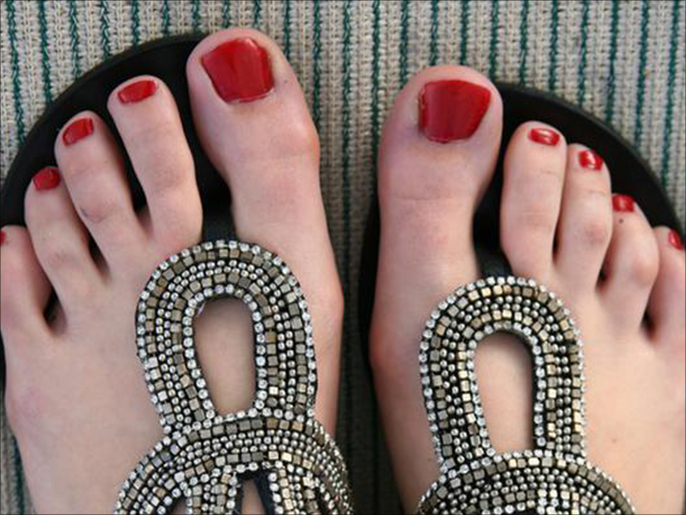Wearing high heels can cause some serious damage to your feet and body in general. Have you ever sprained your ankle while walking in high heels?
It's easy to happen, walking in high heels is not entirely normal.
Here's what will happen if you decide to pull your high-heeled shoes to the back of the closet, said author Agnes Erickson in a report published by Healthdigest.
Walking will be safer
Even after a long period of getting used to wearing heels, you can hurt yourself by spraining or spraining your ankle, because rocky roads, slippery floors, and steep steps are all recipes for disaster, and when you ditch high heels, you'll have more stability.
If you have swollen toes, wearing high heels worsens these problems (Getty Images)
Prevent aggravation of swollen toes
If you have swelling in your big toe joint, wearing high heels can exacerbate these problems, according to Dr. Yolande Ragland, a podiatrist, who told Insider that these infections can grow and become more painful.
Many people have to have surgery to remove them, and you can stop their growth before they get there.
So imagine what would happen if you stopped wearing high heels.
Your toenails won't get hurt
You may have bumped your toe or stuck your toes into tight shoes, especially high-pointed heels. For this small part of your body, nails can cause a lot of pain when injured, and they can change shape.
"Sometimes women come and think they have a fungal nail because the nail looks undernourished, but it's possible that you hurt your toenails because you were wearing high heels, which is usually the case," Ragland says.
So open-toed shoes like slip-on sandals will save your toes.
Open-toed shoes, such as flat sandals, will save your toes (Deutsche Welle)
You may find the solution to your pain
If you've been dealing with hip or back pain for some time, you've probably exhausted most of the potential culprits like leaning at the computer all day, sitting in the car for long periods, but have you thought about putting on your shoes?
If you wear high heels daily, this may be the reason for your suffering.
When you're wearing any type of heeled shoe, your body weight shifts toward the soccer ball, according to Dr. Jackie Sutera, a pediatric surgeon at City Podiatry in New York City. The higher the heel, the more weight and pressure forward, so your knees and hips have to push. forward and your back tilted back, so your skeleton is in a misalignment.
Elongation of the "Achilles heel"
If you have been wearing high heels for a long time and then switched to wearing flats, you will notice that your legs and feet feel tight, and as you know all the muscles work together there.
And it may not be easy to walk because your "Achilles heel" has gotten short over time.
This is what Jackie Sutera confirmed to Silf, adding, "This is why a lot of older women are not satisfied with flat shoes because heels have become narrow due to overuse of high heels throughout their lives."
However, the more you wear flat shoes, you can extend the heels and with time you will feel comfortable walking without high heels.
Metatarsalgia pain relief
Because of the overuse of high heels, the thick lining of the bottom of the foot becomes thinner, Jackie Sutera told Self. "When you don't have natural cushioning, you will have generalized pain on the bottom of the foot. Avoiding occasional shoes slows down the process and gives rest your feet."
Excessive use of high heels makes the thick lining of the bottom of the foot thinner (German)
Do you have plantar fasciitis?
Plantar fasciitis refers to inflammation of a thick line of tissue running through the bottom of your foot. This tissue connects your heel bone to your toes (the plantar fascia), according to the Mayo Clinic.
Interestingly enough, wearing high heels helps alleviate these symptoms.
Well, wearing high heels is not completely bad, but that does not mean any high heels, you need to be selective in finding suitable high heels.
for foot conditions such as plantar fasciitis;
Wearing small heels is helpful, but wearing shoes that are too flat can be hampered, says Julie Schutenstein, who notes that wearing a heel of less than 2 inches stimulates the arch to rise, relieving some discomfort and helping to stretch the fascia.
Reduce the risk of ingrown toenails
If you've been wearing high heels all day, you know what it feels like to finally release your tight toes, it's a total relief.
Speaking to the Women's Health Research Institute, Professor Rodney Estek, Professor of Podiatric Medicine, said, "Ingrown toenails are painful, but some women are willing to deal with this hardship to continue wearing high heels, and it can cause Permanent damage to nails if left untreated.
Avoid wearing occasional shoes and wear flats that give your feet comfort (Getty Images)
Recover the soles of your legs
Wearing high heels causes pain in the soles of your legs and if you think about it you are really working your calf muscles when you are basically standing on your tiptoes.
One study, conducted by Marco Narici of Manchester Metropolitan University in the UK, found that wearing high heels changes the shape of the calf muscles, and when you wear high heels you raise your ankle, making the calves shorter and in a tight position.
And if you do this for a long period of time, the muscles become shorter and shorter.
This can make it uncomfortable when you return to wearing flats, and if you don't want to give up high heels, Naresi recommends extending the soles of your calves after you put on your high heels.

